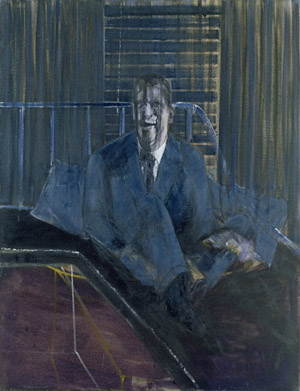Bling Gone Wrong
June 18, 2009
Yes, you definitely shouldn’t buy that.
Turing Would Be Proud…
June 12, 2009
Yet still I am ambivalent after reading this:
Perhaps game engine development might become a secondary concern to character development: the research and development that makes up games could come rely on creation of interesting artificial people, rather than new, stunning visuals, or extra technical trickery. The challenge becomes one not of simulating worlds in more detail, but simulating humanity with greater fidelity. The gaming race would become about building someone interesting enough to keep players engaged, and to keep them coming back.
Maybe Suderman’s suggestion that video games are destined to be art on par with comic books wasn’t the right analogy. Maybe the real destiny of video games is as theater, where the stages are whole worlds and the act of creation is focused on personalities and elaborately constructed response mechanisms, not just fancy scenery and special-effects porn. If that’s actually the direction the medium’s headed, then we’re definitely in for some interesting material… Gives a whole new meaning to the phrase “character development.”
Still, as a general rule, the deeper our entertainments get the more shallow our lives become; flash-bang-geewizz is all fine and good but it hides just how solitary an act being entertained often is. I don’t know if the end result of Nadal and similar technologies will be games with more human contact or less… Or if our interface with the machine will grow so dense that we can’t tell the difference.
One wonders what Milo would think. (Or not think, as the case may be.)
Bringing Home the (Francis) Bacon
June 8, 2009

Very interesting piece on Francis Bacon‘s paintings over at The Smart Set:
There is nothing worse, in Danto’s eyes, than a scream that means nothing. It amounts to the destruction of the moral realm in the name of aesthetics. The key scream painting in Bacon’s oeuvre is probably “Study after Velazquez” (1950). Bacon takes Velazquez’ famous “Portrait of Pope Innocent X” (1650), in which the Pope is a study in cynicism and power and transforms it into one of his blurred, terrifying, screaming heads. The impulse is always to explain this, and other screams through personal history or politics. Bacon was reacting to the horror of his times. Bacon was reacting to the horror of his family life and his later relationships (with their sometimes violent and destructive characteristics). Bacon was reacting to the repressive atmosphere in England regarding his homosexuality. Danto, I think, is correct in rejecting this kind of reductionism. So was Bacon. When asked about his interest in Velasquez’ famous Pope painting, Bacon replied, “I think it’s the magnificent color of it.” He also stated flatly that, “I have never tried to be horrific.” Danto can never forgive Bacon for this sleight of hand.
But Danto, and by extension many other critics, miss a key distinction when they focus on the meaninglessness of the screams. Bacon retreated to the language of pure painting and aestheticism in order to resist the specific meanings often attributed to his works. None of his paintings were explicitly about the wars and genocides of the 20th century. His Pope paintings are not a criticism of the Catholic Church. His more abstract screams are not an expression of Existentialist philosophy.
In fact, Bacon constantly decontextualized his screams (and other portrayals of violence and terror) in order to cut the causal links and to make the screams more general. He was interested in the form and structure of a scream. He wanted to figure out what makes a scream a scream. Painting the scream onto Pope Innocent X heightens that sense of disjunction. It doesn’t make sense that the Pope is screaming. But that makes the scream all the more pure, all the more screamy in its screaminess.
Read the whole thing. I’m always intruiged by the intersection of science and art; not just in how science describes the artistic impulse or how artists portray scientific subject matter, but rather the commonalities that exist between their respective modes of operation. Despite my reservations about the moral underpinnings of his work, the way Bacon is able to evoke, dissect, and taxonomize our repulsion and its objects is intruiging for just that reason. The questions he asks, his method, and final output all share that common, near-scientific mode of questioning. How many screams are there? Is there a general form of scream? How many shapes can they take on? What are the effects of foreground? Background? Where are they rendered banal? Terrifying? etc. And the more complete Bacon’s library has become, the more complete an exploration it is, not just of what horrifies us, but of how we are horrified: he is just as much a psychologist as he is a painter, just as concerned with our categories as he is with our objects.
However, the flipside of this neo-scientific exploration of humanity is a simultaneous forgetting of the particularity of the artist’s self. Bacon’s insistence that his art not be related to his personal experience, his political milleu, his religious inclinations, or his cultural backdrop is familiar, not just because we’ve heard it from the modernist art crowd, but because we hear it from scientists as well, and have for a long time. (From other guys named Francis Bacon, no less!) The primacy of experiential purity, in painting and imagination as much as in method and proof, ties together the other end of the modern aesthetic-scientific complex, and was one of the fulcrum points in the postmodern turn that ultimately left Bacon’s insistance on aesthetics sounding oddly outdated. Yet as I said above, this is part of what makes his work still so compelling: its maybe naive to imagine his work isn’t about homosexuality, Catholicism, genocide, history, or death, but if we want to understand the foibles of the Enlightened mind, Bacon’s art is a striking, and yes, beautiful, place to start.